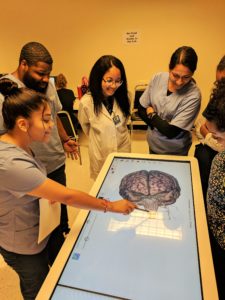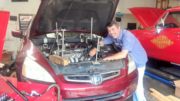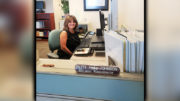By Norma Smith, Arts & Sciences Program Director, Northern, Virginia Campus
 “It’s amazing! The best piece of technology since the Internet!” Perhaps, Terry Powell, a nursing student in Manassas, is a bit more excited about the Anatomage table than your average student might be, but his words definitely capture the furor around the latest technology to come to ECPI University. The Northern Virginia campus has been using the Anatomage table since June, and it has revolutionized anatomy and physiology courses.
“It’s amazing! The best piece of technology since the Internet!” Perhaps, Terry Powell, a nursing student in Manassas, is a bit more excited about the Anatomage table than your average student might be, but his words definitely capture the furor around the latest technology to come to ECPI University. The Northern Virginia campus has been using the Anatomage table since June, and it has revolutionized anatomy and physiology courses.
Imagine taking a full cadaver-filled dissection lab and condensing it into one table, but eliminating all the smells and mess of a real lab. Like doctors-in-training, health science students experience the wonders of working with cadavers, such as tagging parts of the body, penetrating through layers of anatomy, and examining organs at various angles.
The Anatomage table, however, takes studying the human body beyond the constraints of a brick and mortar lab because students can see blood flowing through the donated bodies of their computerized subjects. They can quickly jump from a healthy organ to a diseased one. They can view whole systems and then easily isolate and enlarge an organ within that system, turning it, “cutting” it, and labeling it. The possibilities are mesmerizing, and students are relishing the learning. “It helps me remember more. It’s definitely cool,” says Angel Ramos. “Students don’t have to visualize size. The table is interactive and intuitive. They can cut and undo. Our resources have quadrupled. Really, they feel endless,” says Dr. Erica Jones-Foster.
[Tweet “They can view whole systems and then easily isolate and enlarge an organ within that system, turning it, “cutting” it, and labeling it.”]
While attending the Leadership Institution in 2017-2018, Dr. Jones-Foster was tasked with creating a Classroom of the Future. She had long felt anatomy and physiology were too “dry,” so she was eager to add some innovative technology, something beyond a new Jeopardy or Kahoot game. A simple Internet search brought her to the Anatomage table, and after a few phone calls, she found one in the Northern Virginia area. She knew after the first interaction that students and faculty would benefit from the table, and she was right.
The Anatomage table is perhaps the best piece of technology since the Internet. One thing is for certain, the Classroom of the Future has arrived.
Dr. Erica Jones-Foster, Biology Faculty
Northern Virginia Campus
“I am no longer worried about running out of supplies in the lab, and there’s nothing to drag around from place to place. The table has everything and more,” notes faculty member Melinda Silverio.
“It solves the student engagement problem. Students are no longer just memorizing. The skills check-off allows the learned skills to be demonstrated via their bodies instead of just on paper with rote memorization,” adds Dr. Jones-Foster.
[Tweet ““The Board members firmly believe that this will aid the RAD students in obtaining a more complete understanding of their profession and in excelling in first year clinical settings.””]
After displaying the table to her Advisory Board, Radiology Program Director Terry Henry reported, “The Board members firmly believe that this will aid the RAD students in obtaining a more complete understanding of their profession and in excelling in first year clinical settings.”
One would expect such advanced technology to have a large learning curve, but most students pick it up quickly. “It’s the equivalent to learning how to use an iPad,” says Dr. Jones-Foster.
In summary, for those in a medical field at ECPI, the Anatomage table is perhaps the best piece of technology since the Internet. One thing is for certain, the Classroom of the Future has arrived.








Be the first to comment on "Technological Advances in the Classroom Prepare Students for Future Careers"